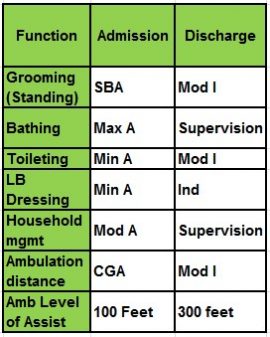One of our patients, a 61-year-old African-American man, came to The Courtyard Rehab following a laminectomy. A retired cook, the patient had lived independently in the community with PRN assistance from family before surgery and admission to rehab. One week after admission, the client complained of chest pain with SOB and was sent to the hospital. A CT scan revealed multiple pulmonary embolisms in the bilateral lungs. The patient was receiving daily Heparin injections prior to hospital readmission. Our approach to treating the patient included the following:
- Patient education on signs, symptoms and risk factors of SOB
- Rated Perceived Exertion Scale, rated 0 to 10 to measure exercise intensity
- Continuous monitoring with pulse oximeter
- Energy conservation techniques
- Low-weight and high-repetition exercises
- Use of Biodex for seated exercise
- Gait training
We observed the following results:
Conclusion
Pulmonary embolism can account for 15 percent of all post-operative deaths, with greater risks associated with those undergoing lower extremity procedures, limb amputations and spinal surgery. Risk factors for PE include prolonged immobilization, status of pre-op blood coagulation, age, gender (males are higher risk) and ethnicity (African-Americans have a 50 percent higher risk.)
As illustrated with our patient, therapists must remain vigilant in monitoring S/Sx and vital signs during therapy of post-surgical patients. It is critical that therapists are aware of risk factors and demonstrate good communication with doctors and nursing regarding any potential change of condition. Due to good interdisciplinary communication and aggressive skilled therapy, this man recovered to his prior level of function and was able to return home.
By Justine de la Fuente MOTR/L


